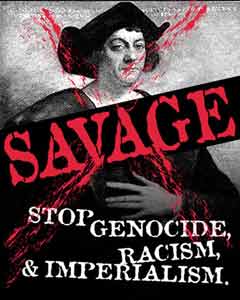Christopher Columbus
Christopher Columbus (between August 25 and October 31, 1451 – May 20,
1506) was a Genoese navigator, colonizer and explorer whose voyages across
the Atlantic Ocean—funded by Queen Isabella of Spain—led to general European
awareness of the American continents in the Western Hemisphere. Although
not the first to reach the Americas from Europe—he was preceded by the Norse,
led by Leif Ericsson, who built a temporary settlement 500 years earlier
at L'Anse aux Meadows[1]— Columbus initiated widespread contact between
Europeans and indigenous Americans. With his several attempts at establishing
a settlement on the island of Hispaniola, he personally initiated the process
of Spanish colonization which foreshadowed general European colonization
of the "New World." (The term "pre-Columbian" is usually
used to refer to the peoples and cultures of the Americas before the arrival
of Columbus and his European successors.)
His initial 1492 voyage came at a critical time of growing national imperialism
and economic competition between developing nation states seeking wealth
from the establishment of trade routes and colonies. In this sociopolitical
climate, Columbus's far-fetched scheme won the attention of Queen Isabella
of Spain. Severely underestimating the circumference of the Earth, he estimated
that a westward route from Iberia to the Indies would be shorter and more
direct than the overland trade route through Arabia. If true, this would
allow Spain entry into the lucrative spice trade — heretofore commanded
by the Arabs and Italians. Following his plotted course, he instead landed
within the Bahamas Archipelago at a locale he named San Salvador. Mistaking
the North-American island for the East-Asian mainland, he referred to its
inhabitants as "Indios".
Handwritten notes by Christopher Columbus on the Latin edition of Marco
Polo's Le livre des merveilles.
The true circumference of the Earth is about 40,000 km (25,000 sm), a figure
established by Eratosthenes in the second century BC, and the distance from
the Canary Islands to Japan 19,600 km (12,200 sm). No ship that was readily
available in the 15th century could carry enough food and fresh water for
such a journey. Most European sailors and navigators concluded, probably
correctly, that sailors undertaking a westward voyage from Europe to Asia
non-stop would die of thirst or starvation long before reaching their destination.
Spain, however, having completed an expensive war, was desperate for a competitive
edge over other European countries in trade with the East Indies.
![]() Return to Indigenous Peoples' Literature
Return to Indigenous Peoples' Literature
Compiled by: Glenn Welker
ghwelker@gmx.com
This site has been accessed 10,000,000 times since February 8, 1996.
This page last updated 10/17/2016 18:46:31